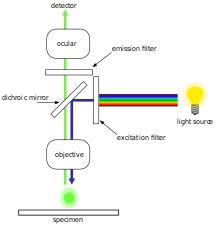question about fluorescence - (Oct/10/2013 )
Hallo all, I am reading the wiki page on fluorescence microscopy but I have a problem with a part of their explenation.
Epifluorescence microscopy<edit>
The majority of fluorescence microscopes, especially those used in the life sciences, are of the epifluorescence design shown in the diagram. Light of the excitation wavelength is focused on the specimen through the objective lens. The fluorescence emitted by the specimen is focused to the detector by the same objective that is used for the excitation which for greatest sensitivity will have a very high numerical aperture. Since most of the excitation light is transmitted through the specimen, only reflected excitatory light reaches the objective together with the emitted light and the epifluorescence method therefore gives a high signal to noise ratio. An additional barrier filter between the objective and the detector can filter out the remaining excitation light from fluorescent light
Ok, what does this red/bold part mean?
the excitation light, this is the light created by the laser (the light source, right?)
And the reflected excitatory light, what is this? This is the light created by the excitation of the fluorophores?
But what is the emitted light than? I was thinking this is also the light created by excitation of the fluorophores, but that does not seem to be the case?
(could be the wrong place to ask this, if so: maybe a moderator can move it.)
Reflected excitory light is the light (independent of fluorescence) reflected back into the objective from the specimen. It will have the same wavelength as the excitory light, and is light that is of little interest when making fluorescent measurements. You want to minimize this light reaching the detector.
Emitted light is light due to fluorescent excitation of molecules in the sample. It is at a different (longer) wavelength than the excitory light, and is the signal you want to reach the detector.
Since most of the excitory light goes through the sample, rather than being reflected from it, this eliminates a lot of the excitory light which might otherwise reach the detector. The fluorescent emitted light is omnidirectional, and a significant amount of it will be captured by the objective.
The filter tries to eliminate the reflected light by selecting the longer wavelength fluorescent light and rejecting the excitory light.
The signal to noise ratio is telling you the efficiency of the entire system in selecting fluorescent signal from excitory background.
phage434 on Thu Oct 10 13:03:47 2013 said:
Reflected excitory light is the light (independent of fluorescence) reflected back into the objective from the specimen. It will have the same wavelength as the excitory light, and is light that is of little interest when making fluorescent measurements. You want to minimize this light reaching the detector.
Emitted light is light due to fluorescent excitation of molecules in the sample. It is at a different (longer) wavelength than the excitory light, and is the signal you want to reach the detector.
Since most of the excitory light goes through the sample, rather than being reflected from it, this eliminates a lot of the excitory light which might otherwise reach the detector. The fluorescent emitted light is omnidirectional, and a significant amount of it will be captured by the objective.
The filter tries to eliminate the reflected light by selecting the longer wavelength fluorescent light and rejecting the excitory light.
The signal to noise ratio is telling you the efficiency of the entire system in selecting fluorescent signal from excitory background.
Ok!
Thanks.
I got a bit confused

